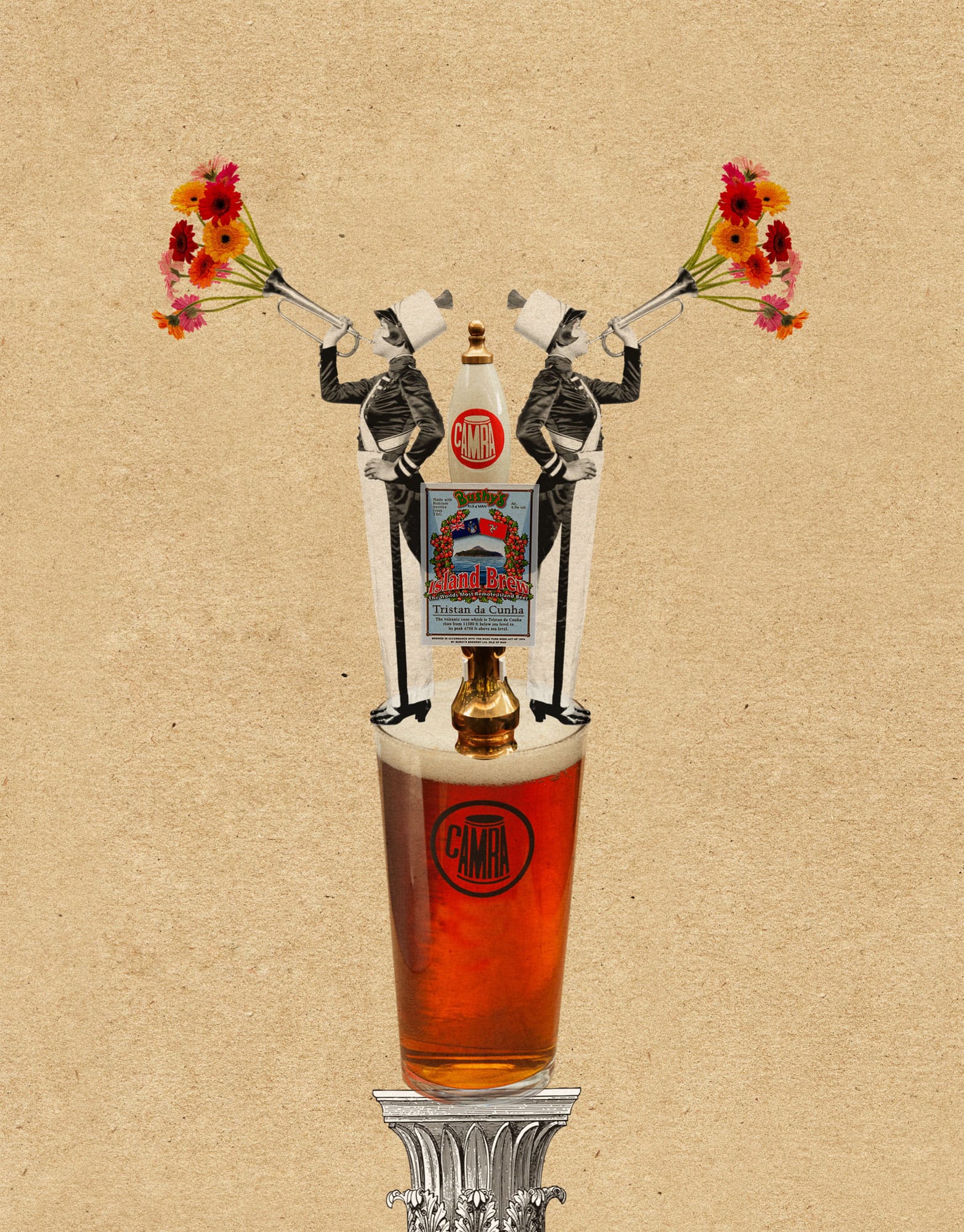
BEER APPRECIATION
BEER APPRECIATION
GLOSSARY
barley wine An ale of British origin, usually amber to bronze in colour. Named because of its wine-like strength, around 8–12% ABV, and predominant malted barley flavour. Usually less bitter than equivalent strength IPAs.
bottle conditioned Beer that continues to ferment in its bottle owing to the presence of yeast. Must be stored upright and, unless a yeasty or hazy style, poured carefully so as not to disturb the sediment.
brewmaster The head brewer of a brewery.
Champion Beer of Britain Title presented by CAMRA (The Campaign for Real Ale) to the British real ale adjudged best in competition at the Great British Beer Festival, an annual beer festival held in London in August. Often abbreviated to CBoB and pronounced ‘see-bob’.
Great American Beer Festival Three-day Beer festival held every September or October in Denver, Colorado. Founded in 1982 to showcase homebrewed beer, it is now the largest craft beer festival in America, with some 800 breweries participating.
imperial stout Originally, an extra strong stout of around 10% ABV brewed by London brewers for export to the Russian Czarina, Catherine the Great, at the Russian Imperial court in the late 18th century. The style became fashionable and was copied widely before falling into decline. Interest in the style has recently been renewed, inspired by modern American brewers’ interpretations. However, the meaning of ‘imperial’ has become vague, and is sometimes as low as 7% ABV. The term ‘imperial’ is now applied to other beer styles brewed to a stronger than expected strength.
New England IPA A beer style that is a variation on the theme of IPA. Typically, it has strong, fruity hop aromas and lower levels of bitterness than are usually associated with American-style IPAs. This is achieved by adding large amounts of hops after the beer has fermented (dry hopping), which also gives the beer a cloudy appearance.
nitro (stout) A stout (or other beer) dispensed using nitrogen under pressure, usually mixed with a much lower proportion of carbon dioxide. The beer emerges with a persistent creamy head and smooth mouthfeel (texture).
Oktoberfest The largest beer festival in Germany, and probably the world, is part of a fayre, which takes place in Munich every year. Beer is served in large tents or marquees seating thousands of guests and is supplied only by the half-dozen large breweries situated within Munich’s boundaries.
oxidized Beer that has become oxidized is considered faulty. A chemical reaction, called oxidation, occurs when oxygen comes into contact with beer during brewing or storage. If not controlled or eliminated, oxidation produces undesirable stale flavours.
real ale Also known as cask ale, a term coined by UK consumer group CAMRA (the Campaign for Real Ale). Real ale undergoes the final stages of its maturation in a container – a cask – without having been pasteurized and with little or no filtration. As live yeast remains, the beer continues to ferment slowly, providing a light, natural carbonation when served. To conform to the definition, the beer must undergo this secondary fermentation in the vessel from which it is served and cannot be dispensed using carbon dioxide (or another gas). Similarly produced beer matured in a bottle can also be real ale.
unfined beer Beer made without the aid of finings, which are used to remove yeast and protein particles in the final stages of production to make beer clearer. Finings are additives usually derived from natural substances; isinglass (made from the swim bladders of fish) is commonly used. Some brewers don’t add finings because it is thought that some desirable flavours and textures may be lost. Because some finings are derived from animal products an unfined beer can usually be relied upon to be suitable for vegans.
wheat beer An ale (usually warm fermented) made with a significant proportion of malted wheat as well as malted barley. Weissenbier (or Weizenbier), the classic German wheat beer originating from Bavaria contain at least 50–70% wheat. Belgian-style witbier usually contains 30–40% wheat. The ‘Weiss-’ and ‘wit-’ parts of the names of these styles mean ‘white’, referring to the whiteish cloudiness of the beers when they are unfiltered.
HOW TO TASTE BEER
the 30-second beer
Tasting beer is not the same as merely drinking it. Anyone can tip beer down their neck then wipe the back of their hand across their mouth, but a little thought enables you to get much more out of it. Before tasting, give your beer a sniff, just as wine lovers do. All its ingredients may contribute to aroma as well as taste, but the popularity of hoppy beers make it likely your first aromatic impression will be from hops. Whatever it’s from, it should be appealing. Next take a sip and pause to consider what you can taste. What does it remind you of, does it please you, do you want more? Answering these questions will assist in forming an opinion of the beer and deciding if it’s the drink for you. Take a second sip and breathe in through your nose to smell the beer at the same time. Taste and smell are inextricably linked and your perception of the beer comes from both. Additional flavours and aromas that you didn’t notice at first may be apparent in the second taste. Consider also how the beer feels in your mouth – thin or full, fizzy or flat – and what sort of aftertaste is left behind. The best beers should both satisfy and also leave you wanting more.
3-SECOND TASTER
Tasting beer is the act of considering its flavour and aroma, rather than simply drinking it without understanding why you like or dislike it.
3-MINUTE BREW
As well as taste, flavour and aroma take time to consider a beer’s appearance – including colour, clarity and head (or foam). Many should be crystal clear with no haze or particles in sight; in others haze is acceptable. Some styles, such as wheat beers, are intentionally cloudy. Brewing trends, such as unfined beer and a style known as New England IPA, have muddied the waters about whether murky beer is appropriate or desirable.
RELATED ENTRIES
See also
3-SECOND BIOGRAPHY
RANDY MOSHER
1952–
Beer evangelist, brewing expert and author of Tasting Beer, a comprehensive guide to understanding and appreciating beer
30-SECOND TEXT
Sophie Atherton
Understanding what it is you’re tasting can make beer all the more enjoyable.
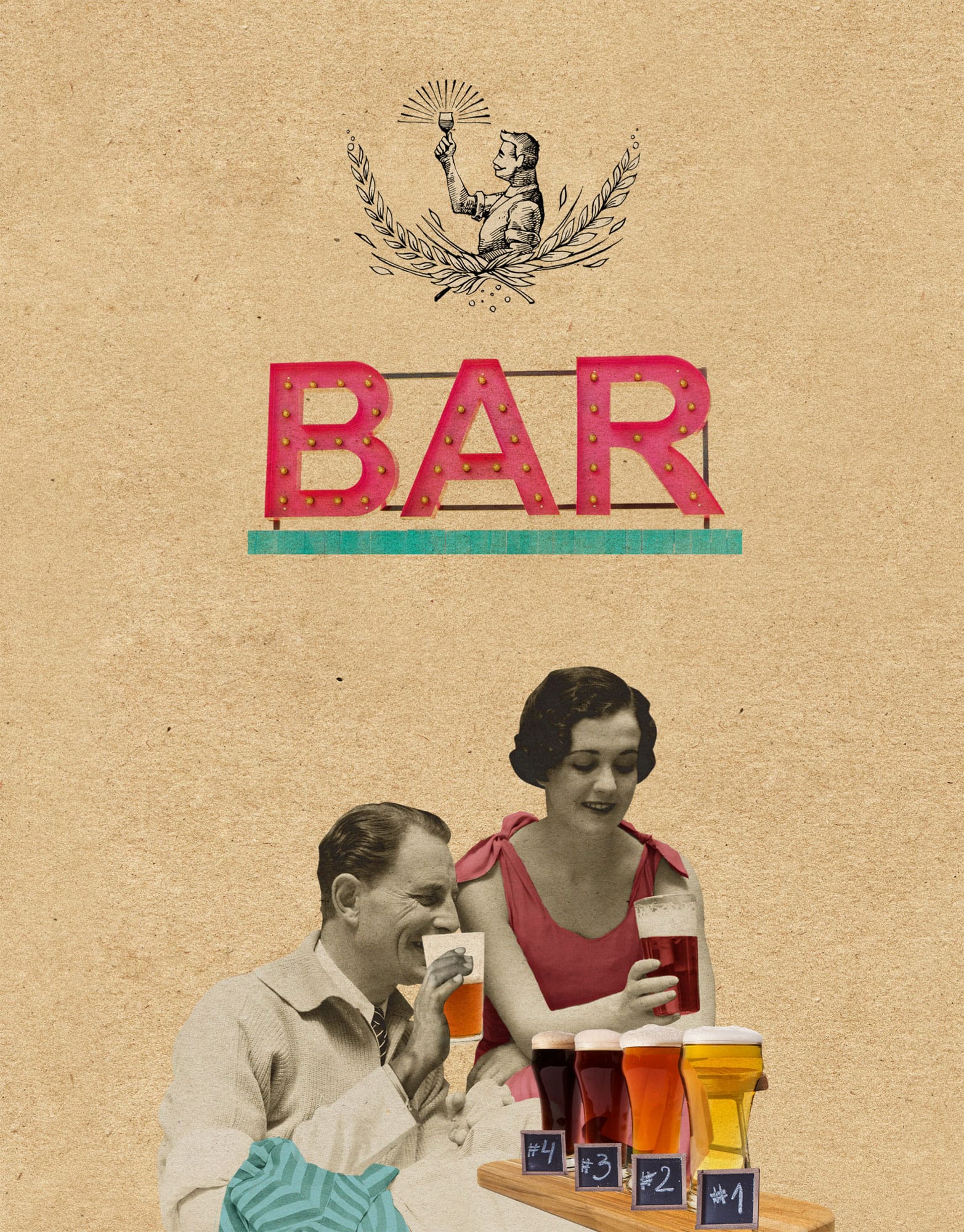
STORAGE & SERVICE
the 30-second beer
Four things matter most when serving beer in the best condition: hygiene, temperature, glassware and the pour. The knowledge and skill of the bartender or publican are what brings it all together. However beer arrives, whether in bottle, can, cask or keg, it’s a sensitive soul and needs to be prepared for service. This varies from simply chilling in a fridge to cellaring for weeks until its condition is just right. Beer needs to be stored in a scrupulously clean environment out of sunlight, at a temperature of 8–12°C (46–54°F). Real ale in particular, like fresh food, has a limited lifespan. While opinions do differ, as a rule, lagers should be served between 6°C and 10°C (43 and 50°F), and cask and keg-conditioned ales between 10°C and 14°C (50 and 57°F). Similar guidelines apply to refrigerated beer, with lagers at the lowest temperatures, and barley wines and imperial stouts brought to room temperature before serving – being too cold tends to mute aroma and flavour. The final act, the pour, is equally important. Judging the right angle and the correct speed to deliver the perfect head of foam takes practice. Guinness is not alone in having its own pouring ritual. Wheat beers, pilsners and nitro stouts are among those requiring special attention, while bottle-conditioned beers need care so as to disturb the yeasty sediment as little as possible.
3-SECOND TASTER
The final steps in its journey from brewer to consumer, the cellaring and service of beer, are time-honoured traditions requiring skill and dedication.
3-MINUTE BREW
Different beers and ales demand different glassware. Flutes concentrate sparkle and accentuate crispness, while a flared shape allows a voluptuous head to form on top of wheat beers and the like. Pint glasses, dimpled and otherwise, deliver a refreshing draught, but to enjoy the fragrance of a hoppy pilsner or a rich old ale, pour it into a tulip-shaped glass or a brandy balloon and give it a swirl.
RELATED ENTRIES
See also
3-SECOND BIOGRAPHIES
VACLAV BERKA
1956–
Third-generation brewmaster at Pilsner Urquell; globetrotting advocate of the proper service and enjoyment of good beer
RAY DANIELS
1958–
Craft beer industry veteran who in 2007 founded the Cicerone Certification Program, the training scheme for those buying and serving beer
30-SECOND TEXT
Susanna Forbes
To serve beer in its best condition, treat each style differently, seeking out the right glassware and checking the serving temperature.
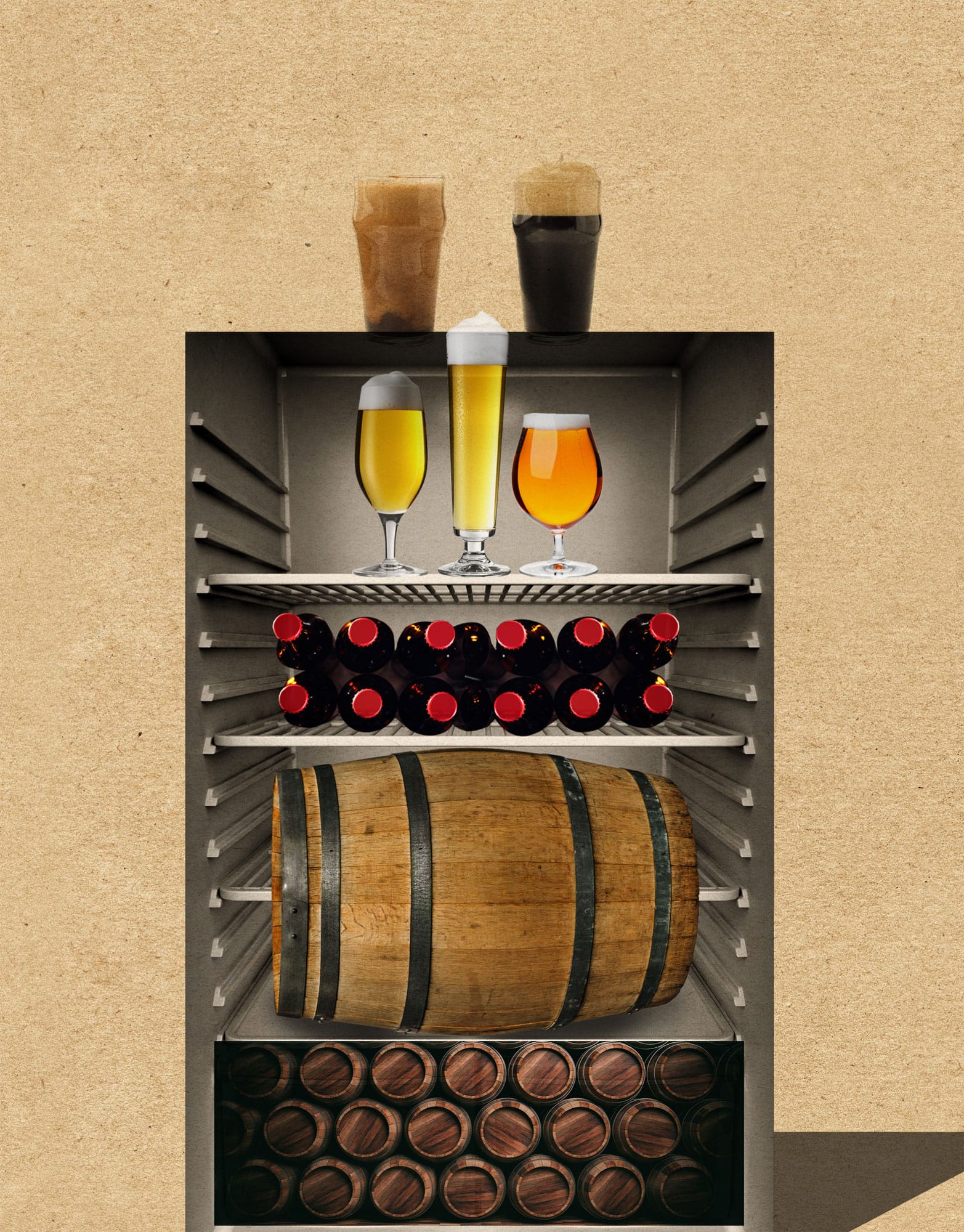
BEER QUALITY
the 30-second beer
Whether draught, bottled or canned, beer should pour with a lively head of foam and be crystal clear in the glass – unless it’s a style meant to have a haze, such as German wheat beer. The major enemies of good beer are oxygen and light. When draught beer is drawn from its container there’s the risk that the carbon dioxide that gives beer its sparkle or ‘condition’ will be replaced by oxygen from the atmosphere. Packaged beers in bottles or cans that have been poorly sealed or left on shelves for too long also run the risk of becoming oxidized. The result is beer with unpleasant wet paper, cardboard or vegetable flavours. Bottled beers left on shelves under bright lights can become ‘light struck’, resulting in a stale and salty flavour. A similar fault is created if beer is left in bright sunshine. Another quality issue is over-carbonation, which can give beer a very fizzy character, as well as creating sensations of prickling and burning. It can also make the drinker feel bloated. While cask beer has low, natural carbonation from secondary fermentation in the container, keg beers and lagers are usually filtered and are served by applied CO2. On the other hand, beer that is under-carbonated (or old or stale) will be flat without a head.
3-SECOND TASTER
Beer is a cool, delicious drink but things can go wrong if it is exposed to oxygen or bright light, or stored in an unsuitable environment.
3-MINUTE BREW
Hygiene is vital when storing and serving beer. Cellars must be kept scrupulously clean and the ‘lines’ or plastic tubes connected to casks and kegs that take beer to the bar must be washed through regularly. Glasses need to be sparkling, free from detergents and kept cool – beer should never be poured into a warm glass taken from the dishwasher. Glasses that haven’t been cleaned properly can also result in flat beer.
RELATED ENTRY
See also
3-SECOND BIOGRAPHY
PAUL NUNNY
1949–
Originally a chartered accountant, Nunny went on to work for Adnams Brewery in Suffolk. His experience here enabled him to co-found Cask Marque, a groundbreaking beer quality accreditation scheme to which some 10,000 British pubs are signed up
30-SECOND TEXT
Roger Protz
Beer can be spoiled without proper care and attention, developing a range of undesirable and unpleasant off flavours.
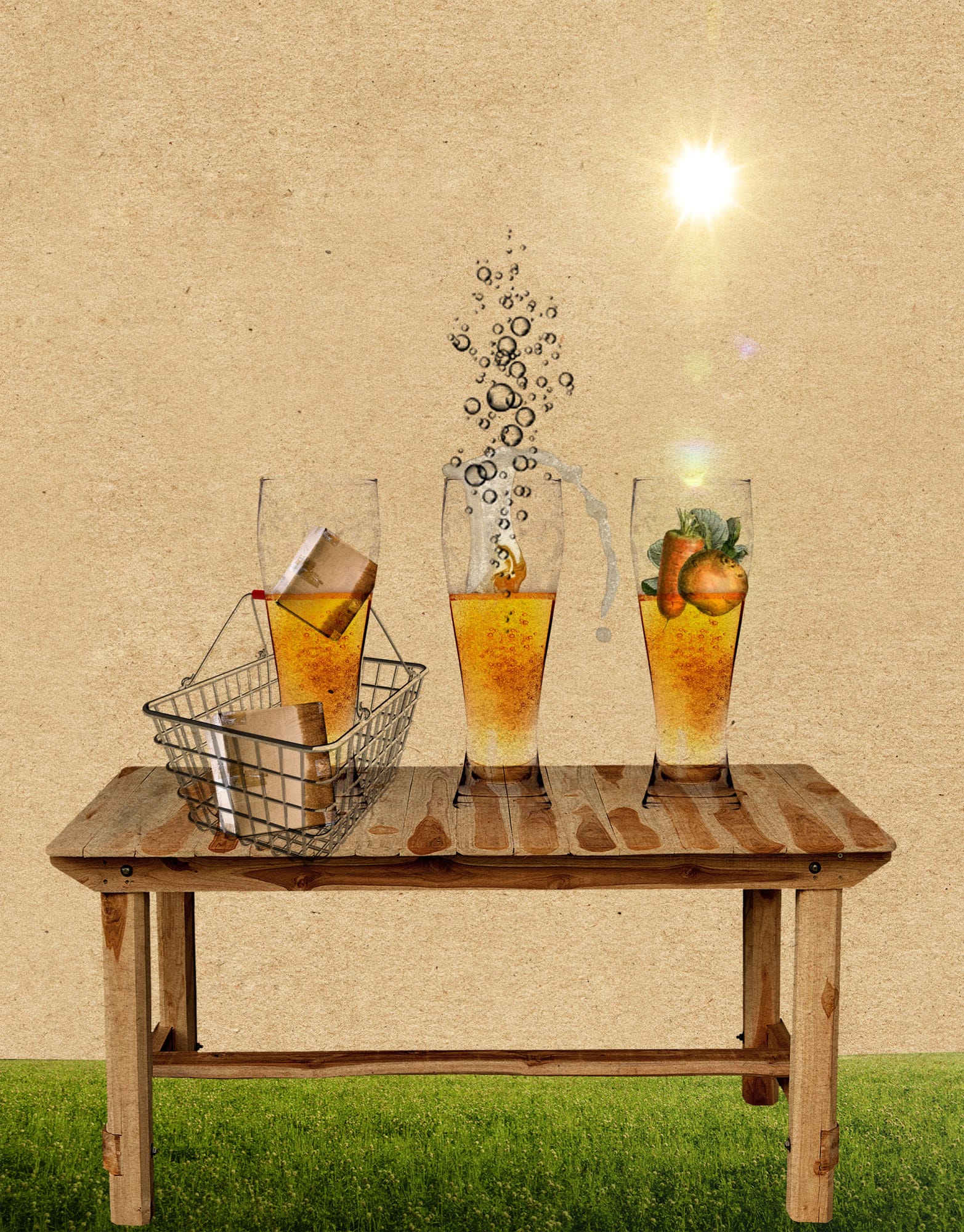
BEER & FOOD MATCHING
the 30-second beer
Beer is a natural partner to food and may be a better match for dining than wine. There are many approaches to matching but the simplest is to consider flavour, balance and intensity – FBI for short. Flavours in both beer and food should work together rather than clashing, in a similar way to how ingredients work in a recipe. In terms of balance, neither beer nor food should overwhelm, although a good match may increase the enjoyment of both or emphasize certain aspects of flavour. Intensity refers to the rule of thumb of pairing subtly flavoured beers with simple, lightly seasoned dishes; medium beers with food that shares similar depth of taste, and intense beers with more strongly flavoured foods. It’s also a reminder to start subtle and work up to strong flavour if matching several courses. The sheer diversity of flavours, often coming from only four basic ingredients, are key to beer’s food pairing versatility, while carbonation is perfect for refreshing and cleansing the palate. Malt naturally echoes many foods from bread and cakes to roasted flavours. Hops have much in common with fruits and spices, but can emphasize spicy heat and bitterness. Yeast can also pose a challenge as it can alter flavours in unexpected ways. The simplest method is experimentation, and taste testing what works, before sharing with others.
3-SECOND TASTER
Matching beer and food needn’t be rocket science; they are perfect partners with many more flavours in common than wine and food.
3-MINUTE BREW
A 2003 book by Brooklyn Brewery’s Garrett Oliver gave beer and food matching a huge boost. Called The Brewmaster’s Table, it remains a seminal work. In Europe, most notably Belgium, pairing beer and food is nothing new and it’s not unusual to find restaurants suggesting beers to match your meal. The rest of the world is still catching up, but the USA and UK are home to plenty of advocates for the idea.
RELATED ENTRIES
See also
3-SECOND BIOGRAPHIES
MARK DORBER
1957–
Pioneering publican, formerly at one of London’s most famous beer specialist pubs: The White Horse, Parsons Green. Early advocate of beer and food matching. Co-founder of beer training organization, The Beer & Cider Academy, which accredits beer sommeliers in the UK
MELISSA COLE
1975–
British beer evangelist and author renowned for her beer and food matching skills and knowledge
30-SECOND TEXT
Sophie Atherton
The right beer and food pairing can make both even more enjoyable, a bit like having good company at the dining table.

BEER WRITING
the 30-second beer
Why write about beer? That is, why write about its flavour or the culture of beer rather than just about how to make it or where to drink some? Because beer is the world’s most popular alcoholic beverage, staggeringly varied, and so, inherently interesting. And, because not everybody knows this, its stories need to be told. Maybe UK journalist Michael Jackson thought something like this when he started writing about beer as a sideline to his day job. In his 1977 book The World Guide to Beer, Jackson used language reminiscent of wine tasting and effectively invented the concept of beer styles. And with Tim Webb separately expounding Belgium’s myriad but almost forgotten beers, there emerged a desire to emulate these beers in the USA. Descriptive writing about beer and its culture took off and gave us beer journalists, guilds of beer writers in North America and Britain, print and online specialist magazines, beer columns in mainstream newspapers and books of all descriptions – some even involving matching beer and food. The internet meant the amateur could contribute, spawning waves of beer blogs, then podcasts. Beer-rating sites soon followed. RateBeer.com’s success attracted investment from brewing giant AB InBev. Four decades on, and various world guides later, there are still many beer stories to be told.
3-SECOND TASTER
The other Michael Jackson revealed world beers, invented modern beer writing and inspired America to re-invent beer – now people rate their pint on social media.
3-MINUTE BREW
As important as books are to beer writing, magazines like All About Beer in the USA, C/O Hops in Sweden and Beer and Brewer in Australia and New Zealand provided outlets for beer enthusiasts to get into print. The internet has made beer writing a truly worldwide phenomenon; you can now read about beer from everywhere anywhere.
RELATED ENTRIES
See also
3-SECOND BIOGRAPHIES
JEAN DE CLERK
1902–78
Belgian brewing technician and author of technical books about beer that led Michael Jackson to think about organizing different beer types as styles
STAN HIERONYMUS
1948–
American beer journalist and amateur brewer. Went full time as a beer writer in 1993. Editor of www.realbeer.com and writes the blog appellationbeer.com. Author of many books about brewing and craft beer
30-SECOND TEXT
Jerry Bartlett
The best beer writing is inclusive, informative and inspiring.

BEER JUDGING
the 30-second beer
Judging beer can be great fun and a fascinating learning experience. It’s a process that takes knowledge acquired through tasting beer for pleasure and places it in a formal context, challenging you to think deeply about the products in front of you and balancing your views with those of other informed people. The process involves evaluating beers on the basis of appearance, aroma, taste and finish, but also, quite often, on how closely they conform to precise styles of beer. Judges work as part of a team and there can be heated discussions before the winner is decided. Some competitions are exclusively judged by brewers or other experts. Others, such as local CAMRA events in the UK or homebrew competitions in the USA, allow participation by amateur enthusiasts. The major beer competition in the USA is held as part of the Great American Beer Festival, echoing the Champion Beer of Britain contest organized by CAMRA in the UK. Many countries or continents now have their own equivalents, such as Birra dell’Anno in Italy and Copa Latinoamericana de Cervezas Artesanales in South America. Globally, there are a number of influential competitions that cross national boundaries, including the World Beer Cup, the International Brewing Awards, the International Beer Challenge, the European Beer Star, the World Beer Awards and the Brussels Beer Challenge.
3-SECOND TASTER
Judging takes beer appreciation to a new level. Competitions demand that every aspect of a beer is scrutinized in order to find the very best.
3-MINUTE BREW
Anyone considering becoming a beer judge can find out more by taking a dedicated beer judging course. The longest established is the Beer Judge Certification Program (BJCP), which, although based in the USA, now offers courses in other countries, too. In the UK, the Beer & Cider Academy runs its own ‘How to Judge Beer’ course. Both courses offer examinations leading to a certificate.
RELATED ENTRY
See also
3-SECOND BIOGRAPHY
PATRICK BAKER
1936–
Co-founder, with Charlie Papazian, of the Beer Judge Certification Program in 1985, with the aim of giving beer judging more credibility
30-SECOND TEXT
Jeff Evans
The best competitions are ‘blind tastings’, with beer only identified by a number, so judges don’t know which beer they are judging.
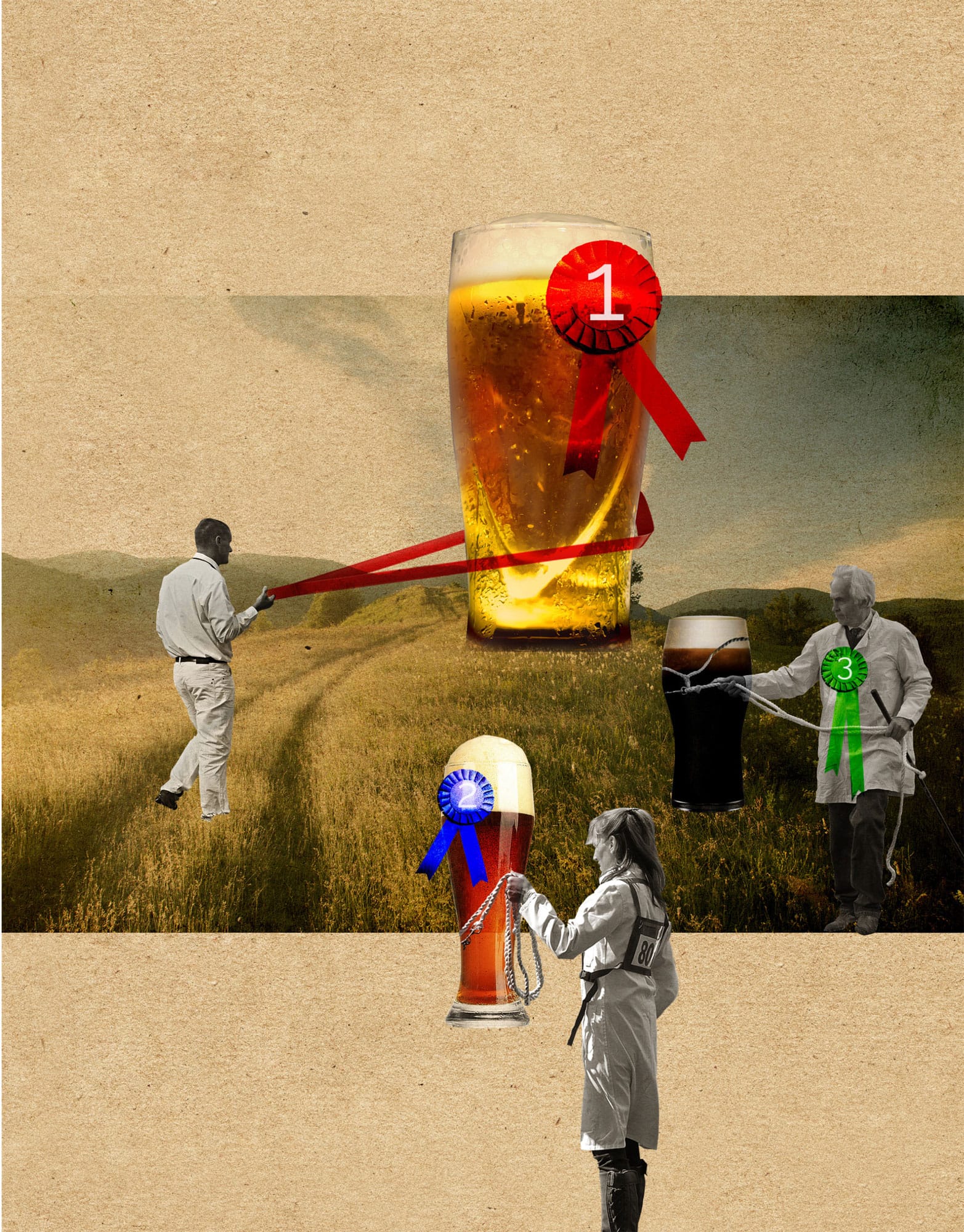
BEER FESTIVALS
the 30-second beer
There is no greater celebration of beer than Munich’s Oktoberfest. This annual party is based around 14 huge beer tents run by the city’s breweries. It is a grand-scale example of many similar cultural events that involve beer around the world, from the humble village fete to sizzling summer barbecues. Events focused more precisely on beer began in the 1970s in the UK, where the Campaign for Real Ale (CAMRA) was looking to draw attention to traditional ales that were disappearing from British pubs. It found the answer in running its own temporary ‘pubs’, using town halls or marquees to present a huge selection of beers that would impress the drinking public. CAMRA still runs dozens of beer festivals, with the pinnacle the Great British Beer Festival in London. This was the template for the Great American Beer Festival, staged in Denver every autumn, and many other events around the world, such as Mondial de la Bière in Canada and Beertopia in Hong Kong. At beer festivals, the public either pays a modest entrance fee and then buys beers as they would in a bar or pays a higher entrance fee and receives free beers as small samples. Both systems enable drinkers to sample a vast array of beers, while also enjoying live music, talks and other entertainment.
3-SECOND TASTER
Beer festivals provide wonderful opportunities to sample an amazing selection of beers of varying styles, from breweries big and small.
3-MINUTE BREW
The Great British Beer Festival, first held in 1977, offers more than 900 beers and attracts more than 40,000 visitors over five days every August. The first Great American Beer Festival was staged in 1982. Just 24 breweries participated, pouring 47 beers, but 800 people showed up, encouraging the American Homebrewers Association, which ran it, to try again the following year. Today, it attracts 800 breweries and some 60,000 attendees over its three-day run.
RELATED ENTRIES
See also
3-SECOND BIOGRAPHY
CROWN PRINCE LUDWIG
1786–1868
The future King Ludwig I of Bavaria whose marriage to Princess Therese of Saxony-Hildburghausen on 12 October 1810 was celebrated with a public party that later developed into the Oktoberfest – the mother of all beer festivals
30-SECOND TEXT
Jeff Evans
Beer festivals provide a wonderful opportunity to celebrate and sample a wide range of brews available in one place.
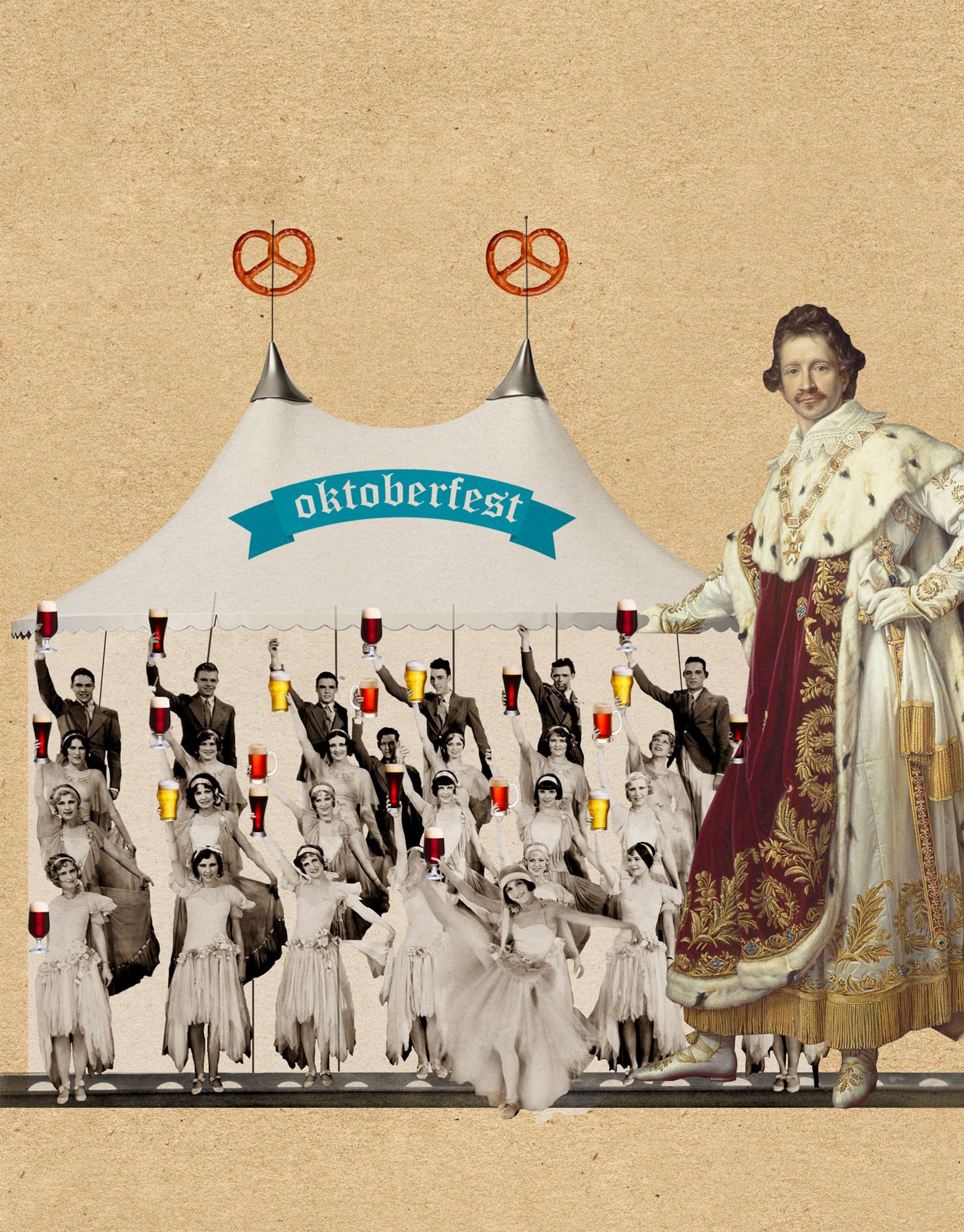
BEER CHAMPIONS
the 30-second beer
The best known and most influential champion of beer is the British Campaign for Real Ale – CAMRA for short. It was founded in 1971 after a series of mergers and takeovers created six large national brewers. They were determined to phase out cask ale and replace it with sweet, gassy and artificially carbonated keg beer. The campaign grew quickly, publishing a monthly newspaper, What’s Brewing, and the annual Good Beer Guide listing all known pubs serving cask beer. Today it has close to 200,000 members and runs beer festivals throughout the UK, featuring beer from independent brewers. CAMRA joined forces with European counterparts in 1990 to form the European Beer Consumers Union (EBCU). The most influential groups were the Objectieve Bierproevers in Belgium – now called Zythos – and PINT in the Netherlands. Members campaign to preserve regional and local beer traditions, support independent breweries and resist attempts to homogenize beer and reduce its diversity and variety. Today there are member organizations in Austria, the Czech Republic, Denmark, Finland, France, Ireland, Italy, the Netherlands, Norway, Poland, Spain, Sweden and Switzerland. CAMRA also has a sister organization in North America, CAMRA Canada.
3-SECOND TASTER
Beer might be a lot less amazing without champions to defend and promote it – probably the most successful example is the UK’s Campaign for Real Ale.
3-MINUTE BREW
Beer’s popularity is cause for celebration and concern. Some value it for the brewer’s skill in creating a wide variety of drinks from just four ingredients; others see it merely as a money maker. Beer champions tend to hold the former view, although that doesn’t mean they think brewing shouldn’t be a business! Beer champions are needed whenever beer quality and diversity is threatened by putting profit ahead of good beer. Other modern threats include rising taxation and the anti-alcohol lobby.
RELATED ENTRIES
See also
3-SECOND BIOGRAPHIES
MICHAEL HARDMAN
1946–
Co-founded CAMRA. Former editor of Good Beer Guide and What’s Brewing. Also co-founded the British Guild of Beer Writers
CONRAD SEIDL
1958–
Known as the Bierpapst or Beer Pope, he writes extensively about Austrian and German beer in the daily newspaper Der Standard
30-SECOND TEXT
Roger Protz
Beer champions make it their mission to tell the world about their favourite drink.
